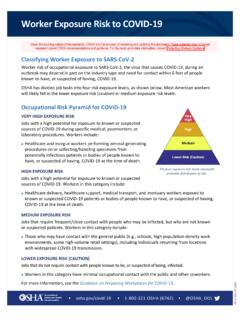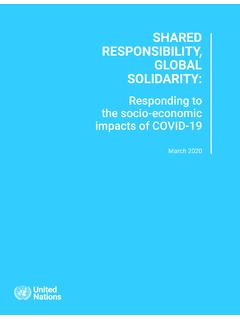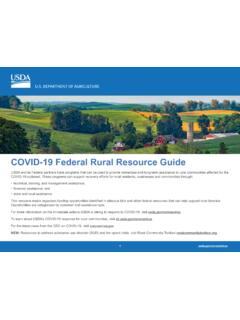Transcription of Asymptomatic Transmission
1 June 12, 2020 Edition 2020-06-12 (21) Page 1 of 12 ** Available on-line at ** The prevalence of Asymptomatic covid -19 cases may vary by population. Examining duration of viral persistence, amount of virus and transmissibility of virus in Asymptomatic individuals is relevant for infection control. Below we summarize three studies that discuss SARS-CoV-2 prevalence and clinical characteristics in Asymptomatic and symptomatic persons. PEER-REVIEWED A. Comparison of clinical characteristics of patients with Asymptomatic vs symptomatic coronavirus disease 2019 in Wuhan, China. Yang et al. JAMA Network Open(May 27, 2020; Correction on June 26, 2020). Key findings: Among 78 early patients in Wuhan with similar exposure histories and treatment course, 33 (42%) were Asymptomatic . Asymptomatic patients shed the virus for a shorter time than symptomatic patients.
2 Asymptomatic patients were more likely to be younger, have faster lung recovery per CT scans, and demonstrate less fluctuation of SARS-CoV-2 testing results. Methods: 78 patients with RT-PCR-confirmed covid -19 with exposure to the Hunan seafood market or close contact with a patient hospitalized for covid -19. NP swabs for RT-PCR were collected every 24 to 48 hours. Limitations: Single hospital; clinical differences between Asymptomatic and symptomatic patients may have been subject to provider bias; "fluctuation" not well defined but may refer to negative tests followed by positive tests. Table: Characteristic Asymptomatic (n=33) Symptomatic (n=45) P-value Age, median, years 37 56 Women 22 14 Incubation period, median, days NA 3 NA Baseline liver injury a 1 9 Duration of viral shedding, median, days b 8 19 Duration of lung recovery, median, days c 9 15 Maximum difference of CD4 cells during treatment, days d 203 328 CD4 cell count during recovery d 719 474 Fluctuated results of PCR test b 4 15 Deaths 0 2 Note: Adapted from Yang et al.
3 Clinical features and prognosis of Asymptomatic and symptomatic patients with covid -19. a Liver injury defined as serum alanine aminotransferase/aspartate aminotransferase levels more than U/L; b Measured via NP swab; c Defined as when lung lesions began to improve by chest computed tomography; d Time from admission to the occurrence of 2 consecutive negative results for SARS-CoV-2 from NP swab. Licensed under CC-BY. Asymptomatic Transmission June 12, 2020 Edition 2020-06-12 (21) Page 2 of 12 B. The natural history and Transmission potential of Asymptomatic SARS-CoV-2 infection. Chau et al. Clinical Infectious Diseases (June 4, 2020). Key findings: Among a convenience sample of patients admitted to a single hospital, 43% were Asymptomatic . Asymptomatic patients had overall lower viral burdens ( , higher Ct values) that became undetectable faster than among symptomatic patients (Figure 1).
4 Asymptomatic patients transmitted infection to contacts (Figure 2). Methods: Prospective study of 30 Vietnamese patients with RT-PCR-confirmed SARS-CoV-2 infection (13 Asymptomatic and 17 symptomatic), from whom NP swabs were collected daily from study enrollment to discharge. Transmissibility in Asymptomatic patients was assessed through contact tracing. Limitations: Small sample size, did not culture virus from RT-PCR positive results to establish infectiousness. Figure 1: Note: Adapted from Chau et al. Ct values over time for Asymptomatic (green) and symptomatic (red) patients. Asymptomatic patients had overall lower viral burdens (higher Ct values) and cleared virus faster than symptomatic patients. Available via Oxford University Press Public Health Emergency Collection through PubMed Central.
5 June 12, 2020 Edition 2020-06-12 (21) Page 3 of 12 Figure 2: Note: Adapted from Chau et al. Epidemiologic links between patients. Asymptomatic patients are in blue and symptomatic patients are in red. Patients positioned on the circle attended an event; arrows indicate patients who tested positive for SARS-CoV-2 after contact with a patient who attended the event and whether they were later classified as symptomatic or Asymptomatic . Available via Oxford University Press Public Health Emergency Collection through PubMed Central. C. Pre-procedural surveillance testing for SARS-CoV-2 in an Asymptomatic population shows low rates of positivity. Mays et al. Journal of Clinical Microbiology. (June 3, 2020). Key findings: <1% of Asymptomatic individuals in the Seattle region seeking medical care without known exposure to covid -19 tested positive for SARS-CoV-2 RNA.
6 O This rate was lower than the rate observed among symptomatic hospitalized patients (10%) and Asymptomatic patients with known exposure (8%) in the same region. Methods: In the University of Washington hospital system, 2,056 Asymptomatic individuals without known exposure had RT-PCR testing before undergoing a surgical or aerosol-generating procedure. Limitations: No follow-up of RT-PCR positive Asymptomatic individuals to verify whether they developed symptoms later. Implications for 3 studies (Yang et al., Chau et al., & Mays et al.): Prevalence of SARS-CoV-2 in Asymptomatic persons may depend on the level of community spread and is likely to vary by region. Asymptomatic persons can transmit to others although virus in the respiratory tract of Asymptomatic persons appears to be present in lower concentrations and for a shorter period than in symptomatic persons, suggesting a shorter period of infectiousness.
7 Infection control practices, including self-isolation and contact tracing, remain necessary for Asymptomatic infected persons. See Oran et al. for a summary of findings from studies on Asymptomatic SARS-CoV-2 infection. June 12, 2020 Edition 2020-06-12 (21) Page 4 of 12 PEER-REVIEWED Characteristics of nursing homes with covid -19 cases. Abrams et al. Journal of the American Geriatrics Society (June 2, 2020). Key findings: In an analysis of 9,395 nursing homes, had 1 documented covid -19 case. o Among nursing homes with at least one covid -19 case, average number of cases per facility was (Figure 1). Larger facility size, urban location, greater percentage of African-American residents, non-chain status, and state were associated with having covid -19 cases. Five-star rating, prior infection control violation, Medicaid dependency and ownership ( , for-profit, nonprofit, government), were not associated with having covid -19 cases.
8 Outbreak size was associated with facility size, for-profit status, and state. Methods: A retrospective analysis of US nursing homes using publicly available data sources. Limitations: Lack of a centralized national reporting system for nursing homes, incomplete and variable reporting of covid -19 and related characteristics. Implications: Nursing homes with certain characteristics ( , larger size, urban location, higher proportion African-American residents) were at an increased likelihood of having covid -19 cases and may merit heightened vigilance for infections and their prevention to protect the health of residents and staff. Figure: Note: From Abrams et al. Frequency distribution of covid -19 cases in 2,575 nursing homes with 1 case reported through May 2020 located in 21 states.
9 Available via Wiley Public Health Emergency Collection through PubMed Central. Epidemiology June 12, 2020 Edition 2020-06-12 (21) Page 5 of 12 Racial disparities in knowledge, attitudes and practices related to covid -19 in the USA. Alobuia et al. Journal of Public Health. (June 3, 2020). Key findings: Although African American and Hispanic persons were less knowledgeable about covid -19 when compared with White persons, they were more likely to practice social distancing and other interventions that reduce the spread of infection (Figure). Persons with higher levels of education or higher income were more knowledgeable about covid -19 but were not more likely to engage in public health interventions to reduce Transmission (Figure). Methods: A multivariate regression analysis using phone survey results from 1,216 persons who participated in the March 2020 Kaiser Family Foundation Coronavirus Poll to identify predictors of covid -19-related knowledge, attitudes and practices.
10 Limitations: Response bias, cross-sectional survey. Implications: Racial and socioeconomic disparities exist in covid -19-related knowledge and practice. Expanded messaging on the public health benefits of social distancing may be needed. Educational resources on covid -19 should be tailored to minority racial and ethnic groups and those of lower socioeconomic status. Figure: Note: Adapted from Alobuia et al. Adjusted odds ratio and 95% confidence intervals on covid -19-related knowledge (blue) and practicing public health interventions (red) stratified by various demographic characteristics. Odds ratio calculations adjusted for race, sex, age, marital status, education level, income, insurance coverage and political views. Reproduced by permission of Oxford University Press on behalf of the Royal Colleges of Physicians of the United Kingdom.















